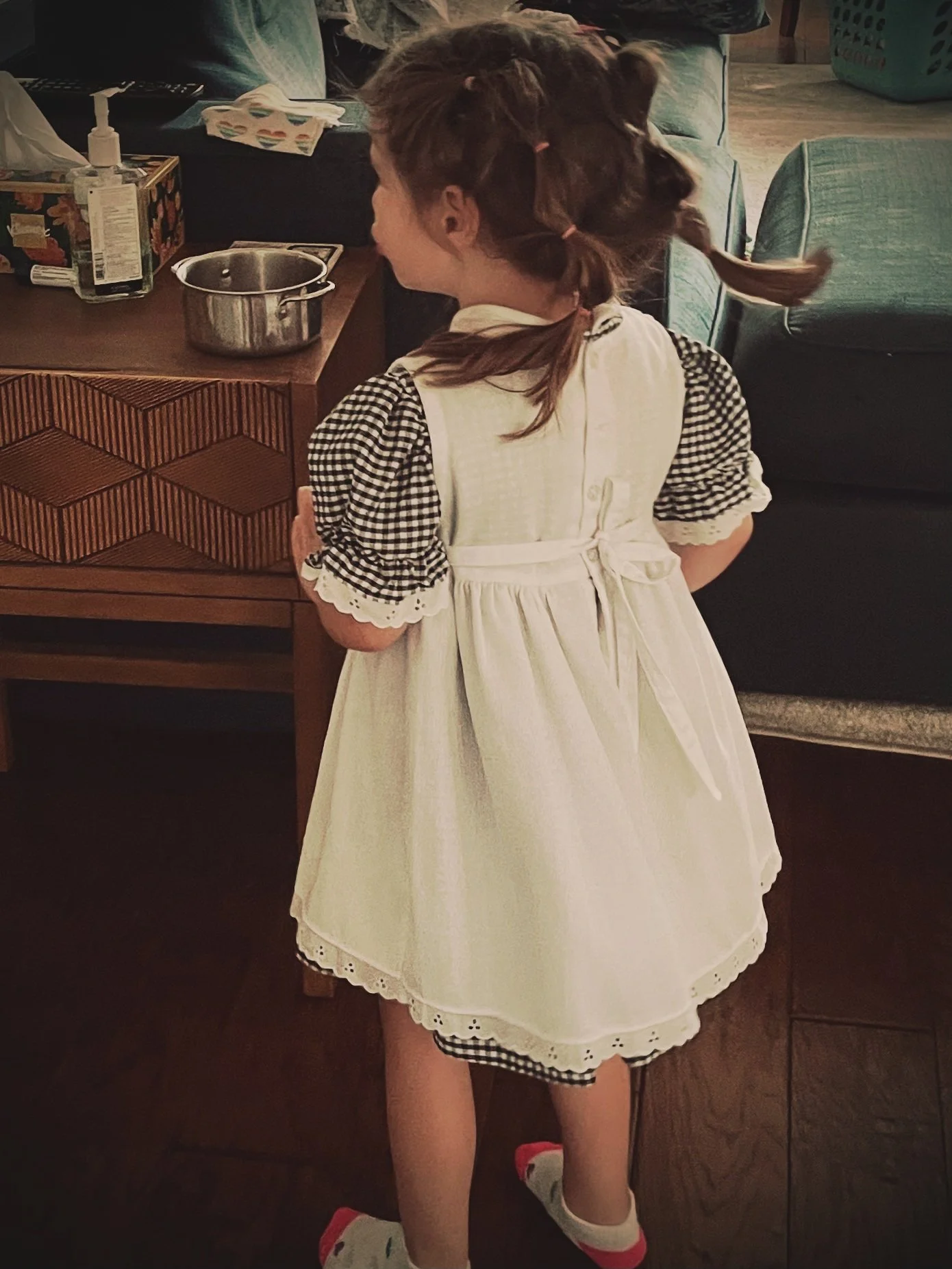The art of reparenting
hoW IT Can Be used to break toxic family cycles
March 2024
She climbed up onto the cornhole board, her chubby little foot teetering dangerously on the edge of the cornhole and threatening to slip through. My heart skipped a beat at the momentary danger. Then she seated herself atop her makeshift slide. She scooted forward, threw her hands in the air for the thrill, and slid off the board's side into the fresh summer mud. The white smocked pinafore and checkered dress I’d worn thirty years before were smeared with earth for the very first time.
I watched my daughter pop back up without a second thought, not even shocked enough by her tiny fall to call out for me. Meanwhile, my nervous system began to spiral into a panic. This dress she’d dug out of a barely-used closet that morning wasn’t supposed to get dirty; it was meant to be beautiful. Pristine, even. In fact, I had repressed all my Southern etiquette training to let her wear it in the first place (it was too fancy for a backyard barbecue). And now she’d gone and stained it. My inner child was screaming.
She’s going to get in trouble, she was saying. You’re going to get in trouble!
As unwelcome as these feelings of panic were, I wasn’t surprised by my overreaction. It was another instance among many throughout motherhood that activated my painful childhood memories. As a young mother I had gone back to talk therapy, terrified by the intensity of emotion my children were bringing out in me. Years later, watching my daughter run around in a muddy dress, my reactions were no less intense. But I now had the tool of reparenting firmly placed in my back pocket.
Reparenting isn’t a new concept, but it has come a long way from its controversial origins. Certain forms of reparenting therapies in the 1970s placed the therapist in the role of a caregiver and the patient within the confines of an institution. Patients would often be intentionally regressed to a childlike state of mind. Fifty years later, self-reparenting is the more common modality, keeping the patient in the driver’s seat. And it’s turned out to be my most successful weapon against toxic family cycles and generational trauma.
“I would describe reparenting as someone, typically an adult, attempting to identify and meet emotional, sometimes physical needs that were not met in childhood,” says Ginny Dalton, a Licensed Clinical Social Worker and Certified Perinatal Mental Health provider. “Needs often include emotion regulation skills, connection, and feeling secure. For many reasons a parent or caregiver was unable to meet those needs and the adult is ‘reparenting’ themselves by learning these ‘new’ skills like a child might.”
Before I learned about modern-day reparenting, I had decided to take a tactical approach to motherhood and cycle-breaking. I knew I wanted my kids to have a very different childhood than my own. I planned to achieve this by simply reflecting on all my childhood pain points and, with the help of a therapist, learning why my parents’ actions were damaging. Then I could heal old wounds and consciously choose not to repeat those patterns of damage and disconnection. I planned to become a parent that responds instead of reacts.
Are you laughing yet? Good. Because you and I both know that no amount of therapy or self-reflection can eliminate a person’s instinct to react to old wounds, parent or otherwise. And nothing could have prepared me for this particular moment with this specific dress, because I hadn’t thought about it since the day I took it off. Before becoming a mother, I could never have predicted that the reappearance of any dress would throw me off balance. Or that it would be just one of many surprise attacks from my past. I never imagined that wounds I didn’t know I had would spontaneously bubble to the surface, often with inconvenient timing. I didn’t realize that my own children would become my biggest activators, requiring me to do so much more than self-reflect.
Reparenting comes hand-in-hand with inner child work. Inner child work might be strutting alongside gentle parenting as the trend du jour, but its theory is firmly rooted in psychological and therapeutic research. Carl Jung is often credited with naming the concept, and experts have developed various approaches to the work over several decades. The theory itself is quite simple: we may grow up, but we retain our memories and emotional experiences from our childhoods. And because our brains naturally associate similar experiences, we can find ourselves responding to familiar situations in adulthood with childlike behaviors and emotions. Our inner child takes over.
If you’ve never done inner child work, you may find it difficult to recognize when your past influences your present. One minute, you’re a fully functional (or at least somewhat functional) adult. The next minute, you’re overwhelmed with emotions that don’t match your situation - a sign that some younger version of yourself has entered the chat. After the moment passes, you wonder where your reaction came from. It doesn’t sit right. Maybe it doesn’t even feel like you. You may even have done something you swore you’d never do, like publicly shame your kid. Once you start connecting with your inner child, you begin to sense when old wounds come into play. More importantly, you get better at interrupting your inner child’s agenda.
The tricky thing about an inner child is they have no idea what year it is. They don’t know that the parent or caregiver they’re afraid of is hundreds of miles away, oblivious to what just happened. They don’t recognize that an adult version of itself is present and fully in control of the situation. They can’t fathom that the upsetting scenario unfolding before them could have a different ending than the one they experienced. And because they are ignorant of all of that, they desperately want to protect you from their bad ending. They also believe they're the best person for the job.
Reparenting yourself is the complex act of assuring that scared inner child of your shared safety and resolving its unmet needs. Easy enough to say, difficult to do. Especially your first few tries. And if you happen to be raising kids, you may find yourself reparenting your inner child while simultaneously parenting your actual child. Throw in some simultaneous small talk with a few folks you just met, and you’ve got yourself one humdinger of a barbecue.
As I fixated on the muddy stain from across the lawn, I recognized that four-year-old me was freaked. Four-year-old me knew damn well that this black and white checkered garment, complete with embroidered roses on a purely decorative pinafore, was a nice dress. She knew it was made to be admired, not played in. It was meant to make me look like a little doll fit for school picture days or dinner outings. It was designed for adults to coo at, not for using cornhole boards as slides. This message had been so successfully driven into my brain that I could even remember the uncomfortable black buckle shoes I was forced to wear with the dress. Not to mention those frilly little bleached-white socks with lace cuffs.
If I had allowed four-year-old me to take the reins after my daughter fell in the mud (which she tried very hard to do), I would’ve marched across the lawn to my daughter. I would have ripped her, mid-climb, off the cornhole board. I would have dragged her to the bathroom and done my best to clean up the dress. All the while saying things like, “We do not treat our nice clothes like this!” Or, “If you get any more dirt on this dress, you will not be allowed to wear it again!”
Why? Because four-year-old me knows that if the dress gets dirty, Mom will be furious with us.
A simple reason backed by a big - and very real - fear. A fear that had been living inside me for thirty years, unseen and unresolved. It was the fear of disconnection and punishment. It was the fear of another rejection from a caregiver I loved, instead of the acceptance I desperately craved. And it would all happen because I wasn’t careful with a dress. And I had always been so careful with this dress.
Those are heavy and complicated fears to tackle, which is why doing inner child work with a licensed professional is generally recommended. “I always encourage individuals to seek out the help of a mental health professional when it comes to inner child work,” says Dalton. “This work can be very activating, so it’s helpful to have a good foundation in grounding, mindfulness, and relaxation skills. This can sometimes be challenging and has to be learned because part of the inner child is often missing those emotion regulation skills.”
Working with a therapist trained in Eye Movement Desensitization Reprocessing (EMDR) or Internal Family Systems Therapy can also help you connect with your inner child on a deeper level, unlocking negative cognitions without re-traumatizing yourself. But access to talk therapy isn’t always available, let alone a trained EMDR specialist. Depending on your childhood experiences, it may be safe to dip your toes in the water on your own using the plethora of resources currently available. “I do encourage anyone working on their own to utilize reputable, evidence-based books, workbooks, podcasts, social media, etc.,” cautions Dalton. “Reading and educating ourselves on any subject can be empowering and a form of regaining control. Just always proceed with caution, recognize your readiness and capacity, and remember to take care of yourself during the process.”
As parents, our children often bring our inner child and all their unresolved issues to the surface simply by being themselves. But it’s also our children that benefit the most from our willingness to reparent when those issues arise. Like a personal Sour Patch Kid, my daughter’s carelessness with this old dress had poked a long-forgotten wound. I was forced to look at it. It hurt. It scared me—a need demanded to be understood and met decades after it first appeared. But I could protect my daughter from having to endure that same wound of fear and disconnection. I could interrupt the damaging family patterns I longed to leave in the past if I acknowledged my inner child’s unmet needs and tried to meet them now.
With my body rooted to the spot and my mind still in panic mode, I smiled at my daughter as she climbed back up the cornhole board. Through my mind’s eye, I imagined picking up my four-year-old self in that same dress with the long-lost black buckle shoes and telling her that we weren’t in trouble. No one was coming to scold us or the little girl across the lawn. There would be no yelling and no public embarrassment. I assured her that I was the boss now. And the boss had decided that it was just a dress. A dress that could get dirty, be easily washed, and then enjoyed all over again without consequence.
As the barbecue wound to a close, the hostess appeared outside with a tray of irresistible cupcakes. My daughter leapt from the cornhole board and bolted to them. In one swift motion, she picked up a cupcake and shoved it, frosting first, into her mouth. A glob of chocolate frosting fell from her chin onto the white Peter Pan dress collar. As my nervous system reached its way back to neutral, I laughed at the messy scene. With a willingness to reparent myself, I had turned an old wound into nothing more than an old dress being played in for the very first time.
This article is currently seeking publication.

